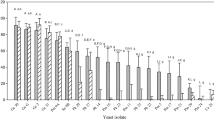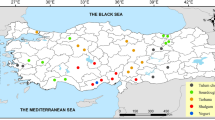Abstract
Kefir—a traditional beverage whose consumption has been associated with health benefits—is a logical natural product to investigate for new probiotic strains. The aim of the present work was to isolate and identify kefir yeasts and select those with acid and bile tolerance to study their adhesion to epithelial cells and their transit through mouse gut. From 4 milky and 3 sugary kefir grains, 34 yeast strains were isolated and identified by means of classical microbiological and molecular-genetic methods (whole-cell protein pattern, internal-transcribed-spacer amplification, and analysis of restriction-fragment–length polymorphisms). We identified 4 species belonging to 3 genera—Saccharomyces cerevisiae (15 strains), Saccharomyces unisporus (6 strains), Issatchenkia occidentalis (4 strains), and Kluyveromyces marxianus (9 strains)—and selected 13 strains on the basis of resistance to low pH and bile salts. Among the strains selected, Kluyveromyces marxianus CIDCA 8154 and Saccharomyces cerevisiae CIDCA 8112 were further studied. Both strains evidenced the capacity to adhere to epithelial intestine-derived cells in vitro and to survive passage through the gastrointestinal tract of BALB/c mice. The investigation of the potential probiotic features of these kefir-yeast strains should be useful for the development of novel functional foods.




Similar content being viewed by others
References
Ahmed Z, Wang Y, Ahmad A, Khan ST, Nisa M, Ahmad H, Afreen A (2013) Kefir and health: a contemporary perspective. Crit Rev Food Sci 53:422–434
Bockelmann W, Heller M, Heller KJ (2008) Identification of yeasts of dairy origin by amplified ribosomal DNA restriction analysis (ARDRA). Int Dairy J 18:1066–1071
Brandão RL, Castro IM, Bambirra EA, Amaral SC, Fietto LG, Tropia MJM, Neves MJ, Dos Santos RG, Gomes NCM, Nicoli JR (1998) Intracellular signal triggered by cholera toxin in Saccharomyces boulardii and Saccharomyces cerevisiae. Appl Environ Microbiol 64:564–568
Clemente Jimenez JM, Mingorence Cazorla L, Martínez Rodriguez S, Las Heras Vázquez FJ, Rodríguez Vico F (2004) Molecular characterization and oenological properties of wine yeasts isolated during spontaneous fermentation of six varieties of grape must. Food Microbiol 21:149–155
Collado MC, Isolauri E, Salminen S, Sanz Y (2009) The impact of probiotic on gut health. Curr Drug Metab 10:68–78
Coton E, Coton M, Levert D, Casaregola S, Sohier D (2006) Yeast ecology in French cider and black olive natural fermentations. Int J Food Microbiol 108:130–135
Czerucka D, Piche T, Rampal P (2007) Review article: yeast as probiotics—Saccharomyces boulardii. Alim Pharmacol Therap 26:767–778
Diosma G (2010) Estudio y selección de levaduras con propiedades probióticas. Magister Thesis. Facultad de Ciencias Agrarias y Forestales. Universidad Nacional de La Plata, Argentina
Edwards-Ingram L, Gitsham P, Burton N, Warhurst G, Clarke I, Hoyle D, Oliver SG, Stateva L (2007) Genotypic and physiological characterization of saccharomyces boulardii, the probiotic strain of Saccharomyces cerevisiae. Appl Environ Microbiol 73:2458–2467
Elmer GW, McFarland LV, Surawicz CM, Danko L, Greenberg RN (1999) Behaviour of Saccharomyces boulardii in recurrent Clostridium difficile disease patients. Aliment Pharmacol Ther 13(12):1663–1668
Esteve Zarzoso B, Belloch C, Uruburu F, Querol A (1999) Identification of yeasts by RFLP analysis of the 5.8S rRNA gene and the two ribosomal internal transcribed spacers. Int J Syst Bacteriol 49:329–337
FAO/WHO (2001) Joint FAO/WHO expert consultation on evaluation of health and nutritional properties of probiotics in food including powder milk with live lactic acid bacteria. Cordoba, Argentina 1–4 October 2001. Available at: http://www.who.int/foodsafety/publications/fs_management/
Farnworth ER (2005) Kefir—a complex probiotic. Food Sci Technol Bull Funct food 2:1–17
Fernandez-Espinar TM, Esteve Zarzoso B, Querol A, Barrio E (2000) RFLP analysis of the internal transcribed spacers and the 5,8S rRNA gene región of the genus Saccharomyces: a fast method for species identification and the differentiation of flor yeasts. Anton Leeuw Int J G 78:87–97
Fleet GH, Balia R (2006) The Public Health and Probiotic Significance of Yeasts in Foods and Beverages. In: Querol A, Fleet G (eds) The yeast handbook. Yeasts in food and beverages. Springer, Heidelberg, pp 381–397
Garrote GL, Abraham AG, De Antoni G (2001) Chemical and microbiological characterization of kefir grains. J Dairy Res 68(4):639–652
Garrote GL, Abraham AG, De Antoni GL (2010) Microbial Interactions in Kefir: a natural probiotic drink. In: Mozzi F, Raya RR, Vignolo GM (eds) Biotechnology of lactic acid bacteria: novel applications. ISBN: 978-0-8138-1583-1. Wiley-Blackwell, Ames, IO, USA, pp 327–340
Golowczyc MA, Mobili P, Garrote GL, Abraham AG, De Antoni GL (2007) Protective action of Lactobacillus kefir carrying S-layer protein against Salmonella enterica serovar Enteritidis. Int J Food Microbiol 118(3):264–273
Klingberg TD, Lesnik U, Arneborg N, Raspor P, Jespersen L (2008) Comparison of Saccharomyces cerevisiae strains of clinical and nonclinical origin by molecular typing and determination of putative virulence traits. FEMS Yeast Res 8(4):631–640
Kociubinski G, Pérez P, De Antoni G (1999) Screening of bile resistance and bile precipitation in lactic acid bacteria and bifidobacteria. J Food Protect 62:905–912
Kourelis A, Kotzamanidis C, Litopoulou-Tzanetaki E, Scouras ZG, Tzanetakis N, Yiangou M (2010) Preliminary probiotic selection of dairy and human yeast strains. J Biol Res-Thessalon 13:93–104
Kumura H, Tanoue Y, Tsukahara M, Tanaka T, Shimazaki K (2004) Screening of dairy yeast strains for probiotic applications. J Dairy Sci 87:4050–4056
Kurtzman CP, Fell JW (1998) The yeasts a taxonomic study, 4th edn. Elsevier, Amsterdam
Laemmli UK (1970) Cleavage of structural proteins during the assembly of the head of bacteriophage T4. Nature 227:680–685
Latorre García L, Castillo Agudo L, Polaina J (2007) Taxonomical classification of yeasts isolated from kefir based on the sequence of their ribosomal RNA genes. World J Microbiol Biotechnol 23:785–791
Londero A, Hamet F, De Antoni GL, Garrote GL, Abraham AG (2012) Kefir grains as a starter for whey fermentation at different temperatures: chemical and microbiological characterization. J Dairy Res 79(3):262–271
Maccaferri S, Klinder A, Brigidi P, Cavina P, Costabile A (2012) Potential probiotic kluyveromyces marxianus B0399 modulates the immune response in caco-2 cells and peripheral blood mononuclear cells and impacts the human gut microbiota in an in vitro colonic model system. Appl Environ Microbiol 78(4):956–964
Mainville I, Robert N, Lee B, Farnworth ER (2006) Polyphasic characterization of the lactic acid bacteria in kefir. Syst Appl Microbiol 29:59–68
Martins FS, Nardi RM, Arantes RM, Rosa CA, Neves MJ, Nicoli JR (2005) Screening of yeasts as probiotic based on capacities to colonize the gastrointestinal tract and to protect against enteropathogen challenge in mice. J Gen Appl Microbiol 51:83–92
Moreira MEC, Santos MHD, Zolini GPP, Wouters ATB, Carvalho JCT, Schneedorf JM (2008) Anti-inflammatory and cicatrizing activities of a carbohydrate fraction isolated from sugary kefir. J Med Food 11(2):356–361
Morelli L (2007) In vitro assessment of probiotic bacteria: from survival to functionality. Int Dairy J 17:1278–1283
Noumi E, Snoussi M, Marcilla Diaz A, Bakhrouf A, Valentin E (2012) Numerical analysis of whole-cell and cell wall proteins’ profiles of human oral cavity Candida isolates. Afr J Microbiol Res 6(21):4503–4511
Orberá Ratón T (2004) Molecular identification methods of yeasts of biotechnological interest. Rev Iberoam Micol 21:15–19
Paramithiotis S, Müller MRA, Ehrmann MA, Tsakalidou E, Seiler H, Vogel R, Kalantzopoulos G (2000) Polyphasic identification of wild yeast strains isolated from Greek sourdoughs. Syst Appl Microbiol 23(1):156–164
Pecquet S, Guillaumin D, Tancrede C, Andremont A (1991) Kinetics of saccharomyces cerevisiae elimination from the intestines of human volunteers and effect of this yeast on resistance to microbial colonization in gnotobiotic mice. Appl Environ Microbiol 57(10):3049–3051
Romanin D, Serradell M, González Maciel D, Lausada N, Garrote GL, Rumbo M (2010) Downregulation of intestinal epithelial innate response by probiotic yeasts isolated fron kefir. Int J Food Microbiol 140:102–108
Saad N, Delattre C, Urdaci M, Schmitter JM, Bressollier P (2013) An overview of the last advances in probiotic and prebiotic field. LWT Food Sci Technol 50:1–16
Senses-Ergul S, Agoston R, Belak A, Deak T (2006) Characterization of some yeasts isolated from foods by traditional and molecular tests. Int J Food Microbiol 108:120–124
Shetty PH, Jespersen L (2006) Saccharomyces cerevisiae and lactic acid bacteria as potential mycotoxin decontaminating agents. Trends Food Sci Tech 17(2):48–55
Szajewska H, Skorka A, Dylan M (2007) Meta-analysis: Saccharomyces boulardii for treating acute diarrhoea in children. Alim Pharmacol Therap 25:257–264
Tasteyre A, Barc M, Karjalainen T, Bourlioux P, Collignon A (2002) Inhibition of in vitro cell adherence of Clostridium difficile by Saccharomyces boulardii. Microb Pathogenesis 32(5):219–225
Tiago FCP, Martins FS, Souza ELS, Pimenta PFP, Araujo HRC, Castro IM, Brandão RL, Nicoli JR (2012) Adhesion to the yeast cell surface as a mechanism for trapping pathogenic bacteria by Saccharomyces probiotics. J Med Microbiol 61(PART 9):1194–1207
van der Aa Kühle A, Skovgaard K, Jespersen L (2005) In vitro screening of probiotic properties of Saccharomyces cerevisiae var. boulardii and food-borne Saccharomyces cerevisiae strains. J Food Microbiol 101:29–39
Vancanneyt M, Van Lerberge E, Berny JF, Hennebert GL, Kersters K (1992) The application of whole-cell protein electrophoresis for the classification and identification of basidiomycetous yeast species. Antonie Van Leeuwenhoek 61(1):69–78
Wyder MT (1998) Identification and characterization of the yeast flora in kefir and smear ripened cheese—contribution of selected yeasts to cheese ripening. PhD Thesis, Swiss Federal Institute of Technology, Zurich
Zanello G, Meurens F, Berri M, Salmon H (2009) Saccharomyces boulardii effects on gastrointestinal diseases. Curr Issues Mol Biol 11:47–58
Acknowledgments
G. Diosma is researcher at the Facultad de Ciencias Agrarias y Forestales of Universidad Nacional de La Plata; A. Londero, F. Rey-Burusco, and D. E. Romanin are fellows; and G. L. Garrote is a researcher of the Consejo Nacional de Investigaciones Científicas y Técnicas (CONICET). This work was supported by Agencia Nacional de Promoción Científica y Tecnológica (ANPCyT), CONICET and UNLP. Dr. Donald F. Haggerty, a retired career investigator and native English speaker, edited the final version of the manuscript.
Author information
Authors and Affiliations
Corresponding author
Rights and permissions
About this article
Cite this article
Diosma, G., Romanin, D.E., Rey-Burusco, M.F. et al. Yeasts from kefir grains: isolation, identification, and probiotic characterization. World J Microbiol Biotechnol 30, 43–53 (2014). https://doi.org/10.1007/s11274-013-1419-9
Received:
Accepted:
Published:
Issue Date:
DOI: https://doi.org/10.1007/s11274-013-1419-9




